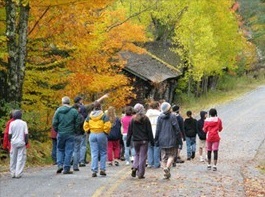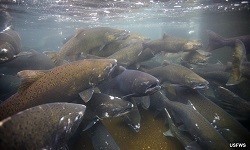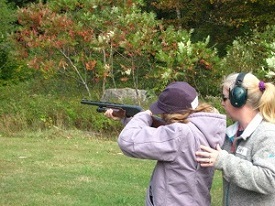Adirondacks, Catskills, & Southern Tier Regions of the NYS Birding Trail Are Live! 
DEC recently announced the opening of the final three regions of the NYS Birding Trail, bringing the number of sites across the state to more than 300. Now the entire NYS Birding Trail is officially open! The Adirondacks-North Country segment of the NYS Birding Trail is now open and includes 41 locations on a mix of public and private lands throughout Clinton, Essex, Franklin, Fulton, Hamilton, Herkimer, Lewis, Montgomery, St. Lawrence, and Warren counties. This region offers birders unique opportunities like the chance to experience historic great camps and views of the Adirondack High Peaks, while also observing boreal species such as loons, boreal chickadees, and the Canada jay. Covering five counties, the Catskills segment includes 23 locations on public lands in Delaware, Greene, Schoharie, Sullivan, and Ulster counties. From Forest Preserve lands and iconic state parks, to a national wildlife refuge and the popular Ashokan Rail Trail, visitors can combine birding with other pursuits like hiking and biking. The Catskills Visitor Center is a great place to start your birding adventure in this region. The Southern Tier segment includes 34 locations in Allegany, Broome, Cattaraugus, Chautauqua, Chemung, Schuyler, Steuben, and Tioga counties. New York's Southern Tier is full of breathtaking scenery, from the deep forests of Allegany State Park to the gorges and towering rock formations of Watkins Glen State Park, Rock City, and McCarty Hill State Forests. With so much natural diversity, birders can enjoy unique opportunities to view a wide variety of wood warblers and other forest bird species. Photo by Adirondack Interpretive Center
New York's Fall Salmon Migration 
Each fall, tributaries to the Great Lakes and Lake Champlain are home to salmon returning to spawn. This can make for some exciting fish watching as salmon move upstream and jump or otherwise navigate various obstructions on their way to their desired spawning sites.
New York is home to a native migratory salmon, the Atlantic salmon. Atlantic salmon are found in many NYS waters as a result of DEC's efforts to reintroduce this species to its native range. Although natural reproduction has been documented, spawning runs of these fish are best found in the Salmon River flowing into Lake Ontario and the Bouquet and Saranac rivers flowing into Lake Champlain.
Coho and Chinook salmon, native to the Pacific Ocean, have been stocked in Lake Ontario since the late 1960s. Good runs of Chinook and Coho salmon can be found in many Lake Ontario tributaries.
Photo by U.S. Fish & Wildlife Service.
First 2022 Case of Epizootic Hemorrhagic Disease Confirmed in Dutchess County DEC recently confirmed that a white-tailed deer in the town of Dover Plains, Dutchess County, died recently after contracting Epizootic Hemorrhagic Disease (EHD). This detection marks the first EHD confirmation in New York for 2022. DEC is investigating reports of several other dead deer from Dutchess County. Once infected with EHD, deer usually die within 36 hours. EHD outbreaks are most common in the late summer and early fall when midges are abundant. Symptoms include fever; hemorrhage in muscle or organs; and swelling of the head, neck, tongue, and lips. A deer infected with EHD may appear lame or dehydrated. Frequently, infected deer will seek out water sources and many die near a water source. There is no treatment or means to prevent EHD. EHD outbreaks do not have a significant long-term impact on deer populations, but deer mortality can be intense in small geographic areas. EHD is prevalent in the southern states where there are annual outbreaks, so some southern deer have developed immunity. In the northeast, EHD outbreaks occur sporadically and deer in New York have no immunity to this virus. Most EHD-infected deer in New York are expected to die. In the north, the first hard frost kills the midges that transmit the disease, ending the EHD outbreak. Important Facts: - EHD virus is an often-fatal disease of deer that is transmitted by biting midges—small bugs often called no-see-ums or 'punkies.'
- The disease is not spread directly from deer to deer.
- Humans cannot be infected by deer or bites from midges.
- The dead deer do not serve as a source of infection for other animals.
Sightings of sick or dying deer should be reported online or to the nearest DEC Regional Office or Environmental Conservation Police Officer. For more information, visit Cornell University's Wildlife Health Lab website.
In-Person Hunting and Trapping Education Courses Available 
New hunters and trappers must first complete a mandatory hunter, bowhunter, or trapper education course before obtaining the appropriate sporting license or hunting privilege. In-person, instructor-led hunter education courses are being offered throughout New York during September and October. Optional waterfowl hunter education courses are also being offered.
All in-person courses require students to review course materials and complete homework materials (found at the links above) prior to attending the classroom and field session. Proof of the completed homework is required to attend the in-person part of the course. All in-person courses will require successful completion of an in-person field day to earn certification for the course.
These courses offer hands-on experience and are free of charge. To locate a hunter or trapper education course, visit DEC's website or contact a local DEC office for assistance. |



No comments:
Post a Comment